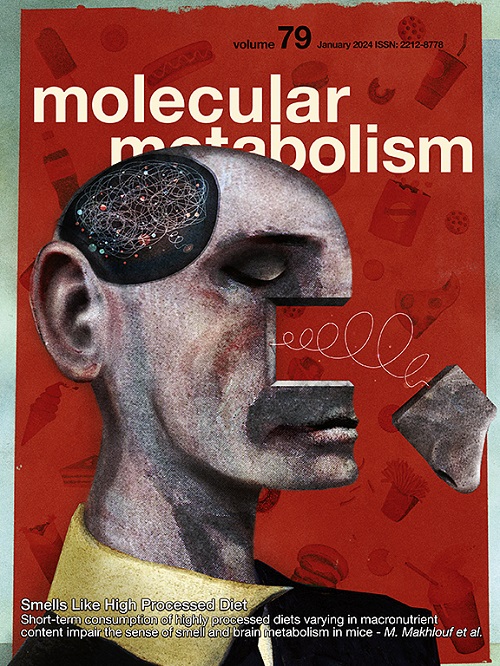Inactivity-induced NR4A3 downregulation in human skeletal muscle affects glucose metabolism and translation: Insights from in vitro analysis
IF 6.6
2区 医学
Q1 ENDOCRINOLOGY & METABOLISM
引用次数: 0
Abstract
Objective
Physical activity promotes health, whereas inactivity is associated with metabolic impairment. The transcription factor nuclear receptor subfamily 4 group A member 3 (NR4A3) is a pleiotropic regulator of skeletal muscle exercise adaptation and metabolism. However, the consequence of lower NR4A3 expression remains largely unexplored. We investigated the impact of NR4A3 downregulation on human skeletal muscle metabolism.
Methods
Published transcriptomic datasets from human bed rest and limb immobilisation studies were curated to meta-analyse the effect of physical inactivity on skeletal muscle NR4A3 levels. In primary human skeletal myotubes, siRNA and lentivirus were used to silence and overexpress NR4A3, respectively. Basal and stimulated (insulin ± leucine) signal transduction was determined by immunoblot analysis. Effects on glucose, fatty acid, and protein metabolism were measured using radiolabelled substrate assays. Lactate production was assessed in culture supernatant by colourimetry. Cell morphology was analysed by immunocytochemistry and gene expression was quantified by RT-qPCR.
Results
Physical inactivity decreased skeletal muscle NR4A3 (−27%), concomitant with pathways related to mitochondrial function, cytoskeleton organization, chromatin regulation, protein synthesis and degradation. Silencing of NR4A3 reduced glucose oxidation (−18%) and increased lactate production (+23%) in vitro. This coincided with greater signalling downstream of AMPK and elevated rates of basal (+26%) and FCCP-stimulated (+55%) fatty acid oxidation. NR4A3 downregulation lowered protein synthesis (−25%), and impaired mTORC1 signalling and ribosomal transcription. Alternatively, overexpression of the canonical NR4A3 protein isoform (+290%) augmented translation and total cellular protein content, which protected myotubes against dexamethasone-induced atrophy. Moreover, partial restoration of NR4A3 levels rescued glucose oxidation in NR4A3-silenced muscle cells and restored phosphorylation of mTORC1 substrates. NR4A3 depletion reduced myotube area (−48%) and further altered protein and gene expression of key contractile elements in skeletal muscle.
Conclusions
Our study connects reduced NR4A3 expression with physical inactivity and indicates that NR4A3 downregulation in human skeletal muscle has adverse effects on glucose metabolism and protein synthesis. Thus, decrements in NR4A3 abundance could be causal in the deleterious health consequences resulting from sedentary lifestyles and targeting NR4A3 may offer new avenues for combating conditions such as disuse muscle atrophy.

人体骨骼肌中不活动诱导的NR4A3下调影响葡萄糖代谢和翻译:来自体外分析的见解
背景:体育活动促进健康,而不活动与代谢障碍有关。转录因子核受体亚家族4A组成员3 (NR4A3)是骨骼肌运动适应和代谢的多效调节因子。然而,NR4A3低表达的结果在很大程度上仍未被探索。我们研究了NR4A3下调对人体骨骼肌代谢的影响。方法:整理来自卧床休息和肢体固定研究的转录组学数据集,荟萃分析缺乏运动对骨骼肌NR4A3水平的影响。在原代人骨骼肌管中,siRNA和慢病毒分别沉默和过表达NR4A3。免疫印迹法测定基础和刺激(胰岛素±亮氨酸)信号转导。对葡萄糖、脂肪酸和蛋白质代谢的影响采用放射性标记底物测定法测定。用比色法测定培养上清的乳酸产量。免疫细胞化学检测细胞形态,RT-qPCR检测基因表达。结果:缺乏运动可降低骨骼肌NR4A3(-27%),并伴有线粒体功能、细胞骨架组织、染色质调节、蛋白质合成和降解等相关途径。沉默核定位的NR4A3蛋白(-30%)可降低葡萄糖氧化(-18%)并增加体外乳酸生成(+23%)。这与AMPK下游更大的信号传导以及基础(+26%)和fccp刺激(+55%)脂肪酸氧化率升高相吻合。NR4A3下调降低了蛋白质合成(-25%),并破坏了mTORC1信号传导和核糖体转录。另外,标准NR4A3蛋白亚型的过表达(+290%)增加了翻译和细胞总蛋白含量,从而保护肌管免受地塞米松诱导的萎缩。此外,NR4A3水平的部分恢复恢复了NR4A3沉默肌肉细胞中的葡萄糖氧化,并恢复了mTORC1底物的磷酸化。NR4A3消耗减少了肌管面积(-48%),并进一步改变了骨骼肌中关键收缩元件的蛋白质和基因表达。结论:我们的研究将NR4A3表达降低与缺乏运动联系起来,表明NR4A3在人体骨骼肌中的下调对葡萄糖代谢和蛋白质合成有不利影响。因此,NR4A3丰度的减少可能是久坐不动的生活方式造成有害健康后果的原因,针对NR4A3可能为对抗废用性肌肉萎缩等疾病提供新的途径。
本文章由计算机程序翻译,如有差异,请以英文原文为准。
求助全文
约1分钟内获得全文
求助全文
来源期刊

Molecular Metabolism
ENDOCRINOLOGY & METABOLISM-
CiteScore
14.50
自引率
2.50%
发文量
219
审稿时长
43 days
期刊介绍:
Molecular Metabolism is a leading journal dedicated to sharing groundbreaking discoveries in the field of energy homeostasis and the underlying factors of metabolic disorders. These disorders include obesity, diabetes, cardiovascular disease, and cancer. Our journal focuses on publishing research driven by hypotheses and conducted to the highest standards, aiming to provide a mechanistic understanding of energy homeostasis-related behavior, physiology, and dysfunction.
We promote interdisciplinary science, covering a broad range of approaches from molecules to humans throughout the lifespan. Our goal is to contribute to transformative research in metabolism, which has the potential to revolutionize the field. By enabling progress in the prognosis, prevention, and ultimately the cure of metabolic disorders and their long-term complications, our journal seeks to better the future of health and well-being.
 求助内容:
求助内容: 应助结果提醒方式:
应助结果提醒方式:


